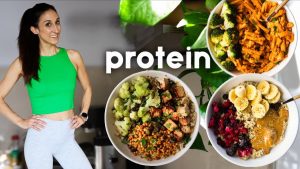Introduction Whether you’re an athlete, a fitness fan, or just trying to improve your health, protein is an essential part of your diet. If you prefer plant-based foods, finding good protein sources might be tricky. But in 2025, there are many plant-based options that are not only nutritious but also help with energy and muscle
Introduction
Whether you’re an athlete, a fitness fan, or just trying to improve your health, protein is an essential part of your diet. If you prefer plant-based foods, finding good protein sources might be tricky. But in 2025, there are many plant-based options that are not only nutritious but also help with energy and muscle recovery.
In this article, we’ll look at the best plant-based protein sources to power your body, support recovery, and keep your diet balanced. From beans to seeds, you’ll find many options that give your body the protein it needs without using animal products.
What Are Plant-Based Proteins?

Image by: Yandex.com
Plant-based proteins come from plants, not animals. While animal proteins come from meat, dairy, and eggs, plant-based proteins are found in vegetables, grains, nuts, seeds, and beans. These proteins are rich in the essential building blocks your body needs and are typically lower in fat, making them a great option for healthy living.
With more people turning to plant-based diets, finding plant proteins is easier than ever. In 2025, many people use these sources to boost energy and recover after exercise. Plant-based proteins also have fiber, vitamins, and antioxidants, which are great for your health.
Top Plant-Based Protein Sources for Energy and Recovery

Image by: Yandex.com
1. Lentils
Lentils are a great source of plant-based protein, offering 18 grams of protein per cooked cup. They’re also high in fiber, which is good for digestion. There are different types of lentils, like red, green, and brown, each giving a different texture and flavor to your meals.
Lentils are also packed with iron, folate, and other key nutrients that boost energy and help recovery after exercise. You can add them to salads, soups, or veggie burgers.
Tip: Combine lentils with quinoa to get a full protein source, as they provide all the essential amino acids.
2. Chickpeas
Chickpeas (or garbanzo beans) offer about 15 grams of protein per cup and are loaded with fiber to support healthy digestion. They’re also packed with vitamins and minerals like manganese and folate, which help keep your energy up.
Chickpeas are versatile and can be used in dishes like hummus, stews, curries, and salads. They’re also great for post-workout meals, as they help muscle recovery while giving you lasting energy.
Tip: Roast chickpeas with olive oil and spices for a crunchy, protein-rich snack.
3. Quinoa
Quinoa is a complete protein, which means it has all nine essential amino acids. This makes it a rare and valuable plant protein source. Besides protein, quinoa is high in fiber, antioxidants, and minerals like magnesium and iron, all of which support energy and recovery.
One cup of cooked quinoa gives about 8 grams of protein, making it an excellent addition to meals, especially for athletes or anyone needing extra protein. It’s also gluten-free, which is good for those with dietary restrictions.
Tip: Use quinoa as a base for grain bowls or add it to soups for more protein.
4. Tofu and Tempeh
Tofu and tempeh are both made from soybeans and are rich in protein. It offers about 10 grams of protein per half-cup serving, while tempeh gives about 15 grams per 3-ounce serving. Both also contain calcium, iron, and magnesium, which are essential for muscle recovery.
Tofu is flexible and absorbs the flavor of what it’s cooked with, while tempeh has a firmer texture and nuttier taste. You can use both in many dishes like stir-fries and sandwiches.
Tip: Marinate tofu or tempeh before grilling or stir-frying to boost the flavor.
5. Hemp Seeds
Hemp seeds are small but pack a punch with 10 grams of protein per 3 tablespoons. They’re rich in healthy fats, including omega-3 and omega-6 fatty acids, which are good for heart health.
Hemp seeds also contain magnesium, which is important for muscle function and recovery. Adding them to your diet can help boost energy levels, especially after workouts.
Tip: Sprinkle hemp seeds on salads, smoothies, or yogurt for a protein boost.
6. Edamame
Edamame (young soybeans) are another great source of protein, offering 17 grams of protein per cooked cup. They’re also rich in fiber, antioxidants, and vitamins that support energy and muscle recovery.
Edamame makes a great snack for those avoiding processed foods. You can enjoy them boiled, steamed, or roasted as a post-workout snack or appetizer.
Tip: Season edamame with sea salt and chili flakes for a tasty, protein-packed treat.
7. Chia Seeds
Chia seeds may be small, but they provide 4 grams of protein in a 2-tablespoon serving. They’re also high in fiber, omega-3 fatty acids, and antioxidants. These nutrients help with recovery and keep energy levels stable.
Chia seeds are versatile and can be added to smoothies, puddings, baked goods, and oatmeal. When mixed with liquid, they form a gel-like consistency, making them a great addition to meals and snacks.
Tip: Mix chia seeds with almond milk and your favorite sweetener to make chia pudding.
Why Plant-Based Protein is Ideal for Energy and Recovery

Image by: Yandex.com
Plant-based proteins have many benefits beyond muscle recovery. Unlike animal proteins, which can have high levels of saturated fats and cholesterol, plant-based proteins are often lower in fat and don’t contain harmful substances like hormones or antibiotics. They’re also rich in fiber, antioxidants, and other nutrients that support overall health.
Plant-based proteins like lentils, chickpeas, and quinoa also contain complex carbs, which provide steady energy throughout the day. This is helpful for athletes or anyone who exercises regularly, as it fuels workouts and speeds up recovery afterward.
Future of Plant-Based Protein Sources in 2025

Image by: Yandex.com
The future of plant-based protein sources looks bright and full of promise. New research is expected to improve how these proteins are produced and used in meals. Advances in food technology may make them even more complete and easier to digest. Many experts believe that more people will include plant proteins in their diets as they learn about the benefits for energy and recovery. With growing demand and better options, these protein sources are set to become even more popular. The future will likely bring more variety and better taste, making it easier to live a healthy and active life.
Comparative Table: Plant-Based Protein Sources
| Protein Source | Protein per Serving (Approx.) | Other Key Nutrients | Best For |
|---|---|---|---|
| Lentils | 18g per cup (cooked) | Iron, Folate, Fiber | Energy, Muscle Recovery |
| Chickpeas | 15g per cup (cooked) | Fiber, Manganese, Copper | Post-Workout, Heart Health |
| Quinoa | 8g per cup (cooked) | Magnesium, Iron, Antioxidants | Balanced Meals, Complete Protein |
| Tofu and Tempeh | 10g (tofu) – 15g (tempeh) | Calcium, Iron, Magnesium | Stir-fries, Vegan Dishes |
| Hemp Seeds | 10g per 3 tbsp | Omega-3 Fatty Acids, Magnesium | Smoothies, Salads, Snacks |
| Edamame | 17g per cup | Fiber, Antioxidants | Post-Workout, Quick Snack |
| Chia Seeds | 4g per 2 tbsp | Omega-3 Fatty Acids, Fiber | Puddings, Smoothies, Oatmeal |
Conclusion
In 2025, plant-based proteins provide many benefits, from boosting energy to aiding in muscle recovery. Whether you’re an athlete or just want to improve your diet, adding these protein-rich foods to your meals can enhance your health and well-being.
From lentils to quinoa, and edamame to chia seeds, there are many plant-based protein options that can help you reach your fitness goals while keeping a balanced, healthy lifestyle. Start adding these nutritious foods to your diet today and see the difference in your energy and recovery.
















